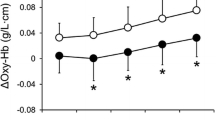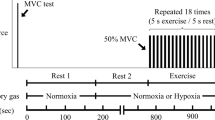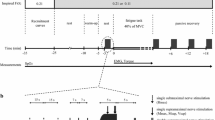Abstract
The aim of the study was to evaluate the influence of chronic hypobaric hypoxia [43 days at 5050 m above sea level, a.s.l.] on the electrical and mechanical activities of the elbow flexor and knee extensor muscles during sustained maximal isometric contractions. Seven subjects participated in this study. The maximal voluntary contraction (MVC) of the two muscle groups was assessed. The subjects were then asked to perform a sustained MVC for 1 min, during which surface EMG and MMG signals were recorded before (SL) and after 43 days at high altitude (HA). From the time and frequency domain analysis of the surface EMG and MMG, the root mean square (RMS) and the mean frequency (MF) were then calculated. After HA exposure, in both the investigated muscle groups the results showed that: (1) the MVC did not change; (2) the maximum force decay during the sustained MVC was similar; (3) surface EMG and MMG parameters did not show any statistical difference. These data suggest that exposure to HA did not affect the electrical and mechanical properties of the two investigated muscle groups. We conclude that exposure to chronic hypobaric hypoxia seems to have no effect on the central motor drive or on muscle performance during sustained maximal isometric contractions of the active muscles.



Similar content being viewed by others
References
Akataki K, Mita K, Watakabe M, Itoh K (2001) Mechanomyogram and force relationship during voluntary isometric ramp contractions of the biceps brachii muscle. Eur J Appl Physiol 84:19–25
Basmajian JV, De Luca CJ (1985) Muscles alive: their functions revealed by electromyography. Williams and Wilkins, Waverly Press, Baltimore
Bevan L, Laouris Y, Reinking RM, Stuart DG (1992) The effect of the stimulation pattern on the fatigue of single motor units in adult cats. J Physiol (Lond) 449:85–108
Bigland-Ritchie B, Woods JJ (1984) Changes in muscle contractile properties and neural control during human muscular fatigue. Muscle Nerve 7:691–699
Burke RE, Levine DN, Tsairis P, Zajac FE 3rd (1973) Physiological types and histochemical profiles in motor units of the cat gastrocnemius. J Physiol (Lond) 234:723–748
Datta AK, Stephens JA (1990) Synchronization of motor unit activity during voluntary contraction in man. J Physiol (Lond) 422:397–419
de Koning FL, Binkhorst RA, Kauer JM, Thijssen HO (1986) Accuracy of an anthropometric estimate of the muscle and bone area in a transversal cross-section of the arm. Int J Sports Med 7:246–249
Diemont B, Figini MM, Orizio C, Perini R, Veicsteinas A (1988) Spectral analysis of muscular sound at low and high contraction level. Int J Biom Comp 23:161–175
Enoka RM, Stuart DG (1985) The contribution of neuroscience to exercise studies. Fed Proc 44:2279–2285
Enoka RM, Stuart DG (1992) Neurobiology of muscle fatigue. J Appl Physiol 72:1631–1648
Esposito F, Malgrati D, Veicsteinas A, Orizio C (1996) Time and frequency domain analysis of electromyogram and sound myogram in the elderly. Eur J Appl Physiol 73:503–510
Ferretti G, Hauser H, di Prampero PE (1990) Maximal muscular power before and after exposure to chronic hypoxia. Int J Sports Med 11 [Suppl. 1]:S31–S34
Freund HJ (1983) Motor unit and muscle activity in voluntary motor control. Physiol Rev 63:387–436
Garner SH, Sutton JR, Burse RL, McComas AJ, Cymerman A, Houston CS (1990) Operation Everest II: neuromuscular performance under conditions of extreme simulated altitude. J Appl Physiol 68:1167–1172
Goldenberg MS, Yack HJ, Cerny FJ, Burton HW (1991) Acoustic myography as an indicator of force during sustained contractions of a small hand muscle. J Appl Physiol 70:87–91
Gordon DA, Enoka RM, Karst GM, Stuart DG (1990) Force development and relaxation in single motor units of adult cats during a standard fatigue test. J Physiol (Lond) 421:583–594
Grimby L (1986) Single motor unit discharge during voluntary contraction and locomotion. In: Jones NL, McCartney N, McComas AJ (eds) Human muscle power. Human Kinetics, Champaign, Ill., pp 116
Kayser B, Bokenkamp R, Binzoni T (1993) Alpha-motoneuron excitability at high altitude. Eur J Appl Physiol 66:1–4
Krogh-Lund C, Jorgensen K (1991) Changes in conduction velocity, median frequency, and root mean square-amplitude of the electromyogram during 25% maximal voluntary contraction of the triceps brachii muscle, to limit of endurance. Eur J Appl Physiol 63:60–69
Lindstrom L, Magnusson R, Petersen I (1970) Muscular fatigue and action potential conduction velocity changes studied with frequency analysis of EMG signals. Electromyography 10:341–356
Linssen WH, Stegeman DF, Joosten EM, van't Hof MA, Binkhorst RA, Notermans SL (1993) Variability and interrelationships of surface EMG parameters during local muscle fatigue. Muscle Nerve 16:849–856
Marsden CD, Meadows JC, Merton PA (1983) "Muscular wisdom" that minimizes fatigue during prolonged effort in man: peak rates of motoneuron discharge and slowing of discharge during fatigue. Adv Neurol 39:169–211
Merletti R, Knaflitz M, De Luca CJ (1990) Myoelectric manifestations of fatigue in voluntary and electrically elicited contractions. J Appl Physiol 69:1810–1820
Moritani T, Muro M (1987) Motor unit activity and surface electromyogram power spectrum during increasing force of contraction. Eur J Appl Physiol 56:260–265
Orizio C (1993) Muscle sound: bases for the introduction of a mechanomyographic signal in muscle studies. Crit Rev Biomed Eng 21:201–243
Orizio C, Veicsteinas A (1992) Soundmyogram analysis during sustained maximal voluntary contraction in sprinters and long distance runners. Int J Sports Med 13:594–599
Orizio C, Perini R, Veicsteinas A (1989) Muscular sound and force relationship during isometric contraction in man. Eur J Appl Physiol 58:528–533
Orizio C, Perini R, Diemont B, Maranzana Figini M, Veicsteinas A (1990) Spectral analysis of muscular sound during isometric contraction of biceps brachii. J Appl Physiol 68:508–512
Orizio C, Perini R, Diemont B, Veicsteinas A (1992) Muscle sound and electromyogram spectrum analysis during exhausting contractions in man. Eur J Appl Physiol 65:1–7
Shinohara M, Kouzaki M, Yoshihisa T, Fukunaga T (1998) Mechanomyogram from the different heads of the quadriceps muscle during incremental knee extension. Eur J Appl Physiol 78:289–295
Yoshitake Y, Moritani T (1999) The muscle sound properties of different muscle fiber types during voluntary and electrically induced contractions. J Electromyogr Kinesiol 9:209–217
Zhang YT, Frank CB, Rangayyan RM, Bell GD (1992) A comparative study of simultaneous vibromyography and electromyography with active human quadriceps. IEEE Trans Biomed Eng 39:1045–1052
Acknowledgements
This work was partly supported by a grant of E.U.L.O. (Ente Universitario Lombardia Orientale). The authors wish to thank the subjects of this study for their committed participation to the experiments.
Author information
Authors and Affiliations
Corresponding author
Rights and permissions
About this article
Cite this article
Esposito, F., Orizio, C., Parrinello, G. et al. Chronic hypobaric hypoxia does not affect electro-mechanical muscle activities during sustained maximal isometric contractions. Eur J Appl Physiol 90, 337–343 (2003). https://doi.org/10.1007/s00421-003-0922-3
Accepted:
Published:
Issue Date:
DOI: https://doi.org/10.1007/s00421-003-0922-3




